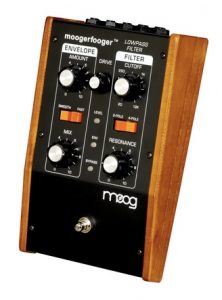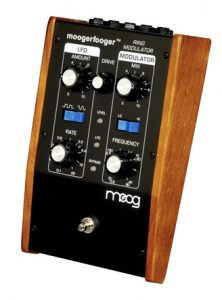There’s always something new and exciting to learn about Moogerfooger pedals by the famous Moog Music Company. As the majority of these effects pedals are derived from original Moog circuits found in early analog Moog synthesizers, it’s clear that these are important tools for the guitarist to know about! Or, at least, that’s the hope. The amount of demo videos with these pedals connected to keyboards is staggering, while the amount of videos with these pedals used with guitars, or more specifically, with realistic, in-context tones, connected to guitars, is minimal. You’ll see a lot of camcorder footage and audio of alien noises. While crazy noises are fun to produce from time to time, I find that most guitarists are seeking tone-shaping pedals that compliment their style rather than propel them to another planet. In other words, effects that add a nice “flavor” to your tone.
I recently had the pleasure of attending Moog Pro Certification at the Moog facility in downtown Asheville, NC. It’s about a 3 hour drive from the Sound Pure shop in Durham, NC. After an in-depth tour, training sessions on all products, Q&A, marketing overview, company history, and new product sneak-peeks, I found myself truly invested in the growth of Moog Music. It’s a culture unto itself and more guitarists need to explore the Moog pedal line.
I own the MF-101 Low Pass Filter. After the educational session on connectivity of multiple Moogerfooger pedals, I am obsessed with saving up for another. The Ring Mod will be my next pedal of choice. I’ve been getting deep into funk and a variety of rock styles lately, and want to employ Moogerfoogers for these styles and more. The ability to connect the CV inputs between pedals to use each other’s functionality is amazing! These pedals alone produce pure analog tone. In combination, they open up a new world of tweakability that is downright fun to explore! No other analog effects have this type of connectivity.
So if you’re saying, “yeah, I know they sound good, but they seem confusing, huge, and expensive,” I’m asking you to re-think those thoughts. Here’s why: once you explore a Moog pedal, you’ll understand that they are not nearly as complicated as you thought. Furthermore, the tone is unique and different from any pedal you’ve played, and discovering new functions and applications is a rewarding experience. The pedals with bucket brigade delay chips are more expensive than others because it’s a rare and expensive part that many say is the very best natural delay sound. All Moog pedals are hand-crafted, piece by piece, at the Asheville headquarters, just like the synths they are famous for. Almost all of these pedals are split into two regions, divided by white lines to indicate functions on each side. These pedals do way more than two pedals worth, so if size is a concern, just think of this as taking the place of 5 or 6 pedals in a 2-pedal space.
Finally, there’s another side of these pedals that comes alive when you connect expression pedals to each one of the main-knob functions. Everything is clearly labeled on the rear panel. BAM! You’ve just expanded your range 10-fold. I’d be happy to provide preferred settings and setup to those interested in exploring an amazing world of Moogerfoorger pedals to really bring your rig to life!
-Ross Gruet



